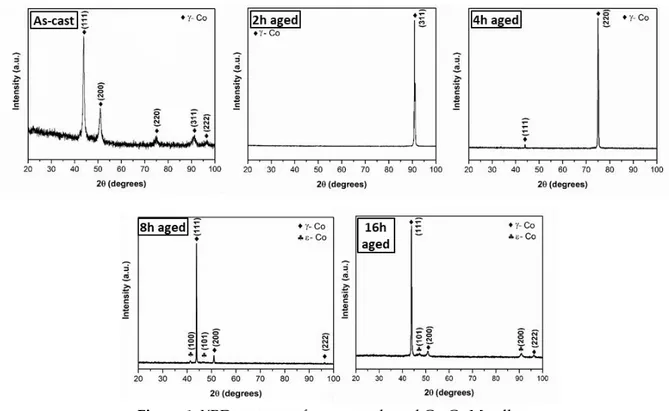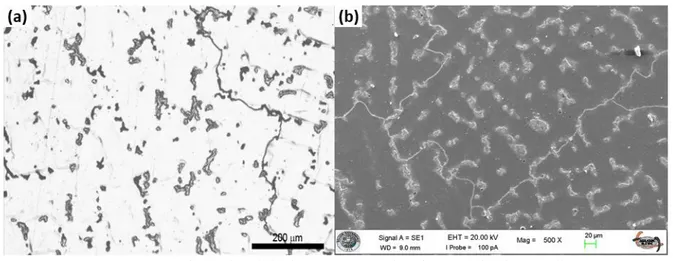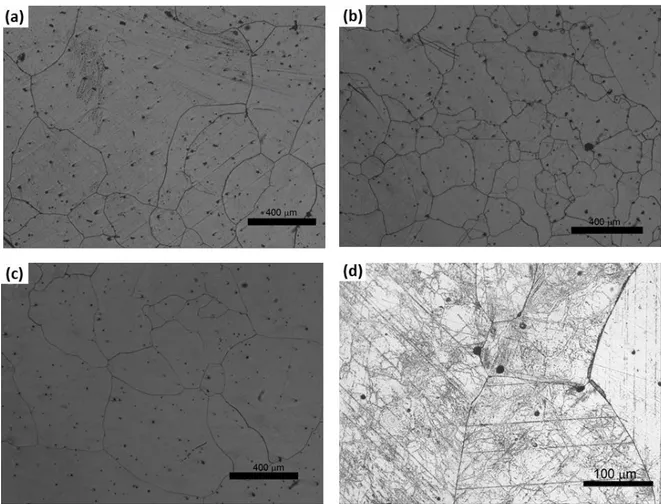EFFECT OF AGING TIME ON PHASE TRANSFORMATION, MICROSTRUCTURE AND HARDNESS OF Co-Cr-Mo ALLOYS
1Mehmet YILDIRIM, 2Ali KELEŞ
1,2Konya Technical University, Faculty of Engineering and Natural Sciences, Department of Metallurgical and Materials Engineering, KONYA, TURKEY
1 ymehmet@selcuk.edu.tr, 2 ali.keles1@outlook.com
(Geliş/Received: 08.08.2018; Kabul/Accepted in Revised Form: 16.09.2018)
ABSTRACT: The effect of heat-treatment on phase relationships, microstructures and hardness of
Co-Cr-Mo alloys were investigated in detail. The samples were produced by investment casting technique and subsequently solutionized (1240 °C for 4 h) and aged (720 °C for 2, 4, 8 and 16 h). Phase analysis of the samples were performed via X-ray diffraction analysis, microstructural examination were done by light optical and scanning electron microscopy. The microstructures of as-cast and short-time (2 and 4 h) aged samples were composed of FCC γ-Co matrix phase and fine M23C6 (where M= Co, Cr and Mo)
precipitates. Increasing the aging time to 8 and 16 h led to partial transformation of FCC γ-Co matrix phase into HCP ε-Co phase. The volume fraction of ε-Co phase increased with increasing aging time. Moreover, hardness of the Co-Cr-Mo samples were significantly enhanced with formation of ε-Co phase. Key Words: Co-Cr-Mo alloys, Hardness, Microstructure
Yaşlandırma Süresinin Co-Cr-Mo Alaşımlarının Faz Dönüşümleri, Mikroyapıları ve Sertliğine Etkisi ÖZ: Bu çalışmada, ısıl işlemin Co-Cr-Mo alaşımlarının faz ilişkileri, mikroyapıları ve sertliklerine etkisi
detaylı biçimde incelenmiştir. Alaşım hassas döküm yöntemiyle üretilmiş, takiben çözeltiye alma (1240 °C’de 4 saat) ve yaşlandırma (720 °C’de 2, 4, 8 ve 16 saat) ısıl işlemi uygulanmıştır. Numunelerin faz analizleri X-ışınları kırınım yöntemiyle, mikroyapıları ise optik ve taramalı elektron mikrokobisi yöntemleriyle incelenmiştir. Dökülmüş haldeki ve kısa süre (2 ve 4 saat) yaşlandırılmış numunelerin mikroyapıları YMK kristal yapısına sahip γ-Co matris fazı ve M23C6 (M= Co, Cr ve Mo) tipi ince karbür
çökeltilerinden meydana gelmektedir. Artan yaşlandırma süresi ile birlikte γ-Co matris fazı kısmen ε-Co fazına dönüşmüştür. ε-Co fazının miktarı artan yaşlandırma süresi ile artmıştır. Ayrıca, ε-Co fazının oluşumu alaşımın sertliğini önemli ölçüde arttırmıştır.
Anahtar Kelimeler: Co-Cr-Mo alaşımları, Mikroyapı, Sertlik
INTRODUCTION
For almost 80 years Co-Cr-Mo alloys have been used as dental and orthopedic implant materials due to their good corrosion and wear resistance, high strength and toughness, elevated fatigue resistance and excellent biocompatibility (Giacchi et al., 2011; Mendes et al., 2017; Zhuang and Wagner, 1989; Bates and Knapton, 1977). Co-Cr-Mo alloys, also known as ASTM F75 (Standard for Co-28Cr-6Mo Alloy Castings and Casting Alloy for Surgical Implants), is composed of 58-69 wt.% Co, 26-30 wt.% Cr, 5-7 wt.% Mo and various elements (ASTM F75 Standard; Davis, 2003; Disegi et al., 1999). In this alloy system, Co is responsible for the modulus of elasticity, Cr provides biocompatibility and also contributes to the
corrosion resistance by forming a protective chromium oxide (Cr2O3) layer, while Mo contributes to the
mechanical properties (Matkovic et al., 2004).
Strengthening mechanism of Co-Cr-Mo alloys is combination of solid solution hardening of Co matrix phase and precipitation hardening due to the formation of M23C6 carbides (Matkovic et al., 2004;
Northwood, 1985; Pickering, 1978). According to the Co-Cr binary phase diagram (Massalski and Okamoto, 1990), Cr has an extended solid solubility in Co and they form two Co-rich solid solutions: (i) γ-Co phase with FCC crystal structure and (ii) ε-Co phase with HCP crystal structure. ε-Co phase is harder than γ-Co phase and enhances the mechanical properties. Moreover, presence of W in alloy composition stabilizes the ε-Co phase in the matrix (Matkovic et al., 2004).
Co-Cr-Mo alloys can be manufactured by various techniques such as powder metallurgy, forging and investment casting technique. Among these methods, investment casting technique is attractive since orthopedic implants having complex shape can be produced at very low cost with dimensions and tolerances very close to the final dimensions (Escobedo et al., 1996; Giacchi et al., 2011). However, poor mechanical properties is the main disadvantage of investment casting technique compared to powder metallurgy and forging. Cast Co-Cr-Mo alloys exhibit lower fatigue resistance and low ductility along with casting and solidification defects such as micro porosity, chemical inhomogeneity large grain sizes (Giacchi et al., 2011; Pickering, 1978; Shi et al., 1994; Lee et al., 2005).
Co-Cr-Mo alloys like other biomedical materials used for dental and orthopedic implants should have reliable physical and mechanical properties (Lee et al., 2006). For example, they should not be fractured in vivo. Thus, their poor mechanical properties should be improved. Proper heat-treatment and alloying additions appear to be effective methods to improve insufficient mechanical properties (Lee et al., 2005).
This study aims to to investigate the effect of heat-treatment on phase relationships, microstructures and hardness of commercial purity Co-Cr-Mo alloys produced by investment casting technique in detail.
MATERIAL AND METHOD
The Co-Cr-Mo alloy was produced by investment casting technique in protective argon atmosphere (details is described elsewhere (Yıldırım and Keleş, 2018)). The chemical composition of the as-cast sample was determined using Oxford Foundry Master Model optical emission spectrometer, and the results are listed in Table 1. The composition of the investigated sample matches with the composition given in the ASTM F75 Standard.
Table 1. Chemical composition of investigated Co-Cr-Mo sample determined from optical emission
spectroscopy analysis
Element Co Cr Mo Fe Si Mn Ni C W
wt.% 64.1 27.7 6.19 0.627 0.681 0.369 0.0385 0.184 < 0.02 Small samples with rectangular cross sections (20 x 10 mm) were cut and then subjected to the heat-treatment. The heat-treatment consisted of a solution treatment at 1240 °C for 4 h followed by water quenching. Aging of the solution treated sample was carried out at 720 °C for 2, 4, 8 and 16 h. All heat-treatment process was performed in a Protherm 130/9 model electrical furnace.
The phase analysis of the as-cast and aged Co-Cr-Mo samples were carried out using X-ray diffraction (XRD) analyses. XRD analyses were conducted using a Bruker D8 Discover Model diffractometer with Cu-Kα radiation (λ=1.54056 Å) and an X-ray source operating voltage of 40 kV. XRD scans were performed in the 2θ range of 20-100 ° using a scanning rate of 2°/min.
Samples for microstructural examination were mechanically grinded (with 120-1200 grit SiC papers), and then polished with 1 µm Al2O3 suspension. Finally, samples were electrotically etched with chromic
acid solution at a voltage of 4 V for 12 s. The microstructures of the samples were examined by Nikon Eclipse MA100 Model inverted optical microscope and SM Zeiss LS-10 Model scanning electron microscope (SEM) equipped with energy dispersive x-ray spectroscopy (EDS).
Rockwell-C hardness measurements were performed using a Digirock RBOV Hardness Tester. 10 kg of preloading, 150 kg of loading and loading time of 10s were used for the hardness testing. The mean hardness values were determined by averaging at least three measurements obtained from each polished sample.
RESULTS AND DISCUSSION
The XRD patterns of the as-cast and aged Co-Cr-Mo alloys are shown in Figure 1. The diffraction patterns of as-cast and short-time (2 and 4 h) aged samples revealed that γ-Co phase with FCC crystal structure (JCPDS Card No: 15-0806) was the only detected phase, while the peaks observed in the long-time (8 and 16 h) aged samples indicated that γ-Co phase is the predominant phase with a small amount of ε-Co phase having HCP crystal structure (JCPDS Card No: 05-0727). However, any diffraction lines corresponding to the neither intermetallic compounds nor carbides were detected.
Figure 1. XRD patterns of as-cast and aged Co-Cr-Mo alloys
The relative amounts of FCC γ-Co and HCP ε-Co phases were predicted by measuring the integrated intensities of the FCC (200) and HCP (101) peaks. The weight fraction of the HCP ε-Co phase was calculated according to the following equation, developed by Sage and Guillaud (Sage and Guillaud, 1950),
𝑓
𝐻𝐶𝑃(𝑤𝑡. %) =
𝐼
101𝐻𝐶𝑃
𝐼
101𝐻𝐶𝑃+ 1.5𝐼
200𝐹𝐶𝐶 (1)where f is fraction of corresponding phase and I is the integrated intensity of the peak present on the XRD diagram. The weight fraction of the HCP ε-Co phase was found to be 3.1 % and 12.5 % for 8 and 16 h aged samples, respectively. Moreover, the lattice parameters of γ-Co phase in as-cast and aged samples were calculated by applying well-known Bragg’s Law, and the results are given in Table 2. The calculated lattice parameters for investigated samples were much higher than that of pure γ-Co phase given as 3.545 Å in standard card file of JCPDS No: 05-0727. The reason for the higher lattice parameter
can be attributed to the atomic radius differences among constituent elements forming the lattice. The solvent element Co, present in the highest quantity of 64 %, and the main solute element Cr, present as 27.7 % in the alloy, have very similar atomic radius of 0.125 nm. However, presence of Mo, which has a larger radius (0.136 nm) than Co and Cr, is believed to increase the lattice parameter of γ-Co phase.
Table 2. Calculated lattice parameters of γ-Co phase in as-cast and aged Co-Cr-Mo alloys Sample Lattice parameter (Å)
As-cast 3.5769
2h aged 3.5811
4h aged 3.5707
8h aged 3.5790
16h aged 3.5829
Optical and SEM micrographs of as-cast Co-Cr-Mo samples are given in Figure 2. The microstructure of the as-cast Co-Cr-Mo alloy consisted of γ-Co based dendrites and fine precipitates present at interdendritic zones and grain boundaries. These precipitates can be identified as M23C6
(where M= Co, Cr and Mo) carbides according to the EDS measurements (Figure 3). The measured compositions of γ-Co matrix phase and precipitates are listed in Table 3. Based on these results, measured composition of γ-Co phase was similar to the composition obtained from spectrometric analysis. Exact composition of the precipitates should be determined via EPMA-WDS analysis since the EDS is a semi-quantitative technique. However, the observed microstructures of as-cast alloy agreed well with those reported in the literature (Giacchi et al., 2011; Sims et al., 1987; Ramirez et al., 2009; Kilner et al., 1982). In addition, some amount of solidification and casting defects such as micropores and flaws were observed in the microstructure of as-cast alloy. The presence of such defects was probably due to the high pouring temperature.
Figure 2. (a) Optical and (b) SEM micrographs of as-cast Co-Cr-Mo alloys
The optical micrographs of aged Co-Cr-Mo samples are shown in Figure 4. The microstructure of the as-cast sample significantly changed after solutionizing and aging treatments. The microstructures of short-time (2 and 4 h) aged samples consisted of γ-Co based coarse grains and M23C6 carbides distributed
along the grain boundaries as a hard skeleton, while the microstructures of long-time (8 and 16 h) aged samples consisted of mainly γ-Co based coarse grains and small amount of ε-Co martensite type microstructures with grain boundary M23C6 carbides. The grain sizes of aged samples varied between
200-350 µm depending on the aging time. 8 and 16 h isothermal aging resulted in the transformation of FCC γ-Co phase into HCP ε-Co phase. The ε-Co phase, also known as athermal martensite, nucleated randomly at the grain boundaries and inside the grains of FCC γ-Co phase developing a pearlite-like
morphology having thick and discontinuous bands. The reason for the dual phase formation, FCC to HCP transformation, can be explained with stacking faults.
Figure 3. EDS analysis of as-cast Co-Cr-Mo alloys (a) γ-Co based matrix phase and
(b) M23C6 carbides.
Table 3. Chemical composition of the γ-Co phase and M23C6 carbide determined from
EDS analysis (wt.%)
Element Co Cr Mo Fe Si Others
γ-Co phase 67.1 26.6 5.18 2.5 0.6 Balance
M23C6 carbide 34.9 31.9 18.4 1.9 0.8 Balance
It is well-known that when dislocations separate into Shockley partials because of the low stacking fault energy, FCC stacking faults are formed (Garcia et al., 1999; Lopez and Garcia, 2008).These stacking faults can be considered as potential HCP ε-Co nucleus since Shockley partial dislocations on FCC planes produce HCP crystals. Olson and Cohen (Olson and Cohen, 1976) presented that high temperature annealing above γ-Co ↔ ε-Co transformation temperature led to formation of stacking faults. Therefore, as this study also shows, potential nucleation sites for HCP ε-Co phase would be increased with increasing aging temperature and time (Garcia et al., 1999).
Figure 4. Optical micrographs of aged Co-Cr-Mo alloys (a) 2 h, (b) 4 h, (c) 8 h and (d) 16h.
The results of the hardness measurements for as-cast and aged samples are listed in Table 4. As-cast and short-time aged samples exhibited very similar hardness values. However, long-time aging increased the hardness values significantly. This increase is directly attributed to the FCC γ-Co ↔ HCP ε-Co transformation after certain aging time. HCP ε-Co phase is harder than FCC γ-Co phase and age hardening of Co-Cr-Mo samples increased the amount of HCP ε-Co phase. The measured hardness values for the investigated samples mainly met the ASTM F75 standard hardness values (25-35 HRC) except for 16 h aged sample. The high hardness value for 16h aged sample may result in fracture of the sample. In order to avoid fracture, such a long aging time should not be preferred.
Table 4. Hardness values for as-cast and aged Co-Cr-Mo alloys Sample Hardness (HRC) As-cast 27.1 2h aged 24.7 4h aged 25.7 8h aged 36.7 16h aged 42.1
The present study reports promising properties of Co-Cr-Mo alloys. 8 h aged sample presented here exhibit good structural and mechanical properties and can be used as a material for orthopedic and dental implants.
CONCLUSIONS
The effect of heat-treatment on phase relationships, microstructures and hardness of Co-Cr-Mo alloys were investigated in detail and the following conclusions can be drawn.
The microstructure of the as-cast alloy consisted of γ-Co based dendrites and fine M23C6 carbides
at interdendritic zones and grain boundaries.
After solution and aging treatments M23C6 carbides distributed along the grain boundaries of γ-Co
based coarse grains.
Transformation of FCC γ-Co ↔ HCP ε-Co was observed after 8 and 16 h aging time.
FCC γ-Co ↔ HCP ε-Co transformation led to significant increase in hardness values.
High hardness value of 42.1 HRC for 16 h aged sample did not meet the ASTM F75 standard.
ACKNOWLEDGEMENT
This work was supported by the Selçuk University Scientific Research Projects Fund under grant number 17201148. The author Ali KELEŞ gratefully acknowledge Sistem Ortopedi, where he worked as a metallurgical and materials engineer formerly, for production of the samples.
REFERENCES
ASTM F75-12 Standard, 2012, “Co-28Cr-6Mo Alloy castings and casting alloy for surgical implants”. Bates, J. F., Knapton, A. G., 1977, “Metals and alloys in dentistry”, International Metals Review, Vol. 22,
No 1, pp. 39-60.
Davis, J. R., 2003, Handbook of materials for medical devices, ASM International, Materials Park, OH, USA.
Disegi, J. A., Kennedy, R. L., Pilliar, R., 1999, Cobalt based alloys for biomedical applications, ASTM, West Conshohocken, PA, USA.
Escobedo, J., Mendez, J., Cortes, D., Gomez, J., Mendez, M., Mancha, H., 1996, “Effect of nitrogen on the microstructure and mechanical properties of a CoCrMo alloy”, Materials and Design, Vol. 17, pp. 79-83.
Garcia, A. J. S., Medrano, A. M., Rodriguez A.S., 1999, “Formation of HCP martensite during the isothermal aging of an FCC Co-27Cr-5Mo-0.05C orthopedic implant alloy”, Metallurgical and Materials Transactions A, Vol. 30A, pp. 1177-1184.
Giacchi, J. V., Morando, C. N., Fornaro, O., Palacio, H. A., 2011, “Microstructural characterization of as-cast biocompatible Co-Cr-Mo alloys”, Materials Characterization, Vol. 62, pp. 53-61.
Kilner, T., Pilliar, R. M., Weatherly, G. C., Alibert, C., 1982, “Phase identification and incipient melting in a cast CoCr surgical implant alloy”, Journal of Biomedical Materials Research, Vol. 16, pp. 63– 79.
Lee, S. H., Takahashi, E., Nomura, N., Chiba, A., 2005, “Effect of heat treatment on microstructure and mechanical properties of Ni- and C-Free Co-Cr-Mo alloys for medical applications”, Materials Transactions, Vol. 46, No 8, pp. 1790-1793.
Lee, S. H., Takahashi, E., Nomura, N., Chiba, A., 2006, “Effect of carbon addition on microstructure and mechanical properties of a wrought Co-Cr-Mo implant alloy”, Materials Transactions, Vol. 47, No 2, pp. 287-290.
Lopez, H. F., Garcia, A. J. S., 2008, “Martensitic transformation in a cast Co-Cr-Mo-C alloy”, Metallurgical and Materials Transactions A, Vol. 39A, pp. 8-18.
Massalski, T.B., Okamoto, H., 1990, Binary Alloy Phase Diagrams, ASM International, Materials Park, OH.
Matkovic, T., Matkovic, P., Malina, J., 2004, “Effects of Ni and Mo on the microstructure and some other properties of Co-Cr dental alloys”, Journal of Alloys and Compounds, Vol. 366, pp. 293-297.
Mendes, P. S. N., Lins, J. F. C., Mendes, P. S. N., Prudente, W. R., Siqueira, R. P., Pereira, R. E., Rocha, S. M. S., Leoni, A. R., 2017, “Microstructural Characterization of Co-Cr-Mo-W Alloy as Casting for Odonatological Application”, International Journal of Engineering Research and Application, Vol. 7, No 3, pp. 34-37.
Northwood, D. O., 1985, “The development and applications of zirconium alloys”, Materials and Design, Vol. 6, No 2, pp. 58-70.
Olson, G. B., Cohen, M., 1976, “A general mechanism of martensitic nucleation: Part I. General concepts and the FCC → HCP transformation”, Metallurgical Transactions A, Vol. 7, No 12, pp. 1915-1923.
Pickering, F. B., 1978, Physical metallurgy and design of steels, Applied Science, Essex, UK.
Ramirez, V. L. E., Castro, R. M., Herrera, T. M, García, L. C. V., Almanza, C. E., 2009, “Cooling rate and carbon content effect on the fraction of secondary phases precipitate in as-cast microstructure of ASTM F75 alloy”, Journal of Material Processing Technology, Vol. 209, pp. 1681–1687. Sage, M., Gillaud, C., 1950, “Méthode d'analyse quantitative des variétés allotropiques du cobalt par les
rayons X”, Review Metallurgy, Vol. 47, No 2, pp. 139-145.
Shi, L., Northwood, O. D., Zhengwang, C., 1994, “The properties of a wrought biomedical cobalt-chromium alloy”, Journal of Materials Science, Vol. 29, No 5, pp. 1233-1238.
Sims, C. T., Hagel, W., Stoloff, N., 1987, The superalloys II: High temperature materials for aerospace and industrial power, Wiley & Sons, Hoboken, NJ, USA.
Yıldırım, M., Keleş, A., 2018, “Production of Co-Cr-Mo Biomedical Alloys via Investment Casting Technique”, Turkish Journal of Electromechanics & Energy, Vol. 3, No 1, pp. 12-16.
Zhuang, L. Z., Wagner, E. W., 1989, “Effects of cooling rate control during the solidification process on the microstructure and mechanical properties of cast Co-Cr-Mo alloy used for surgical implants”, Journal of Materials Science, Vol. 24, No 2, pp. 381-388.




